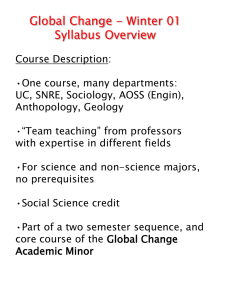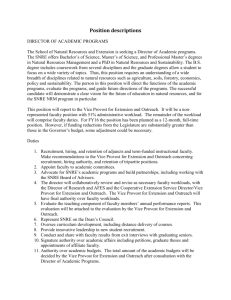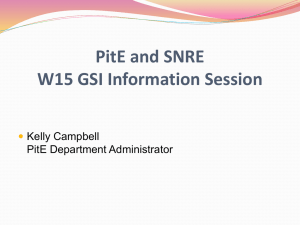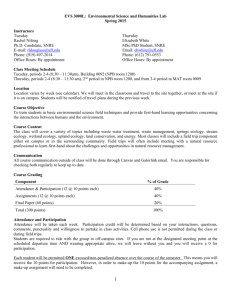– CALS Unit Strategic Planning Phase III
advertisement
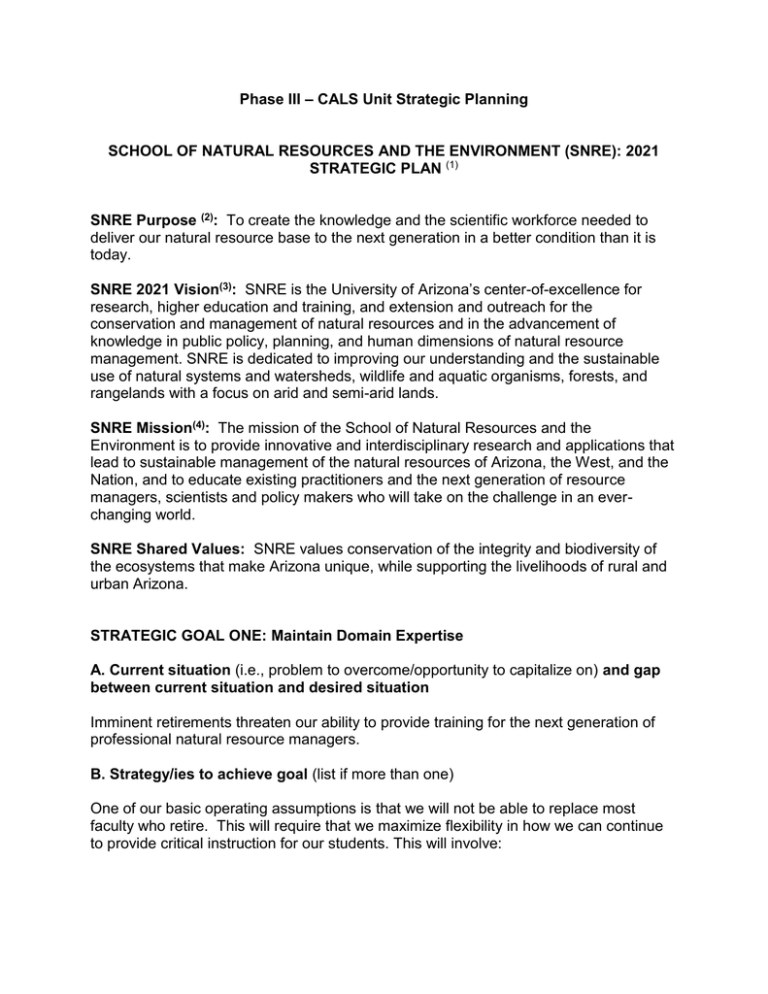
Phase III – CALS Unit Strategic Planning SCHOOL OF NATURAL RESOURCES AND THE ENVIRONMENT (SNRE): 2021 STRATEGIC PLAN (1) SNRE Purpose (2): To create the knowledge and the scientific workforce needed to deliver our natural resource base to the next generation in a better condition than it is today. SNRE 2021 Vision(3): SNRE is the University of Arizona’s center-of-excellence for research, higher education and training, and extension and outreach for the conservation and management of natural resources and in the advancement of knowledge in public policy, planning, and human dimensions of natural resource management. SNRE is dedicated to improving our understanding and the sustainable use of natural systems and watersheds, wildlife and aquatic organisms, forests, and rangelands with a focus on arid and semi-arid lands. SNRE Mission(4): The mission of the School of Natural Resources and the Environment is to provide innovative and interdisciplinary research and applications that lead to sustainable management of the natural resources of Arizona, the West, and the Nation, and to educate existing practitioners and the next generation of resource managers, scientists and policy makers who will take on the challenge in an everchanging world. SNRE Shared Values: SNRE values conservation of the integrity and biodiversity of the ecosystems that make Arizona unique, while supporting the livelihoods of rural and urban Arizona. STRATEGIC GOAL ONE: Maintain Domain Expertise A. Current situation (i.e., problem to overcome/opportunity to capitalize on) and gap between current situation and desired situation Imminent retirements threaten our ability to provide training for the next generation of professional natural resource managers. B. Strategy/ies to achieve goal (list if more than one) One of our basic operating assumptions is that we will not be able to replace most faculty who retire. This will require that we maximize flexibility in how we can continue to provide critical instruction for our students. This will involve: 1. De-couple course responsibility from individual faculty members, to the degree this is possible to enhance flexibility to allow: a. Team teaching using existing faculty b. Recruitment of uniquely-qualified lecturers from the community 2. Make a case for replacement of faculty who are uniquely critical to our mission. C. Actions Time Period (Fiscal Years) 2013-2015 First, we will identify specific needs that must be met to maintain our ability to train professionals who can be certified by professional societies in natural resources. Second, we will inventory the skills of our faculty and match them to our instructional needs. This will allow us to assemble a teaching team to offer the most critical courses. Third, we will identify professionals in Tucson (retired and active) who might be recruited to (a) offer entire courses, or (b) fill identified gaps in what our inhouse teams might be able to provide. D. Inputs needed to achieve the goal (do not limit to financial inputs) An internal and external inventory of internal professional expertise coupled with a matrix of instructional requirements and development of a business plan to support payment to local professionals when necessary. E. Objective Metrics that will be used to track progress towards attaining goal Progress and success will be measured by the continued accreditation of our programs and the ability of our students to meet professional certification. Notes (if any) STRATEGIC GOAL TWO: Strengthen and Diversify Revenue Streams A. Current situation (i.e., problem to overcome/opportunity to capitalize on) and gap between current situation and desired situation It is certain that state support will continue to decline. In the face of this decline, we must develop other revenue streams that are available to us. First, while SNRE has the largest graduate program in CALS, both our undergraduate program and our student credit hour production are modest. Second, we have very strong relationships with Federal and State land management agencies and conservation organizations. Research opportunities will be enhanced with the siting of the new Department of Interior Climate Science Center within SNRE. Third, our relationship with management and conservation agencies and our international prominence as a center for arid/semiarid land management offers unmatched opportunities for training career professionals. Pursuit of all three opportunities should enhance our funding situation. B. Strategy/ies to achieve goal (list if more than one) 1. Increase student credit hours and number of undergraduates in our Natural Resources major 2. Increase revenues from sponsored research 3. Re-invigorate professional training programs offered by School faculty and personnel C. Actions Time Period (Fiscal Years) 2013-2016 Overall: We will establish an incentive system that will reward faculty members who contribute to each of the goals listed above (i.e., return some portion of the revenues generated through RCM, IDC, or professional training to actively involved faculty within the first year. B.1. We will: (1) enhance our website to be more attractive and informative for prospective undergraduates (one year); (2) offer 2 more undergraduate (Tiers 1 and 2) classes to attract new majors (two years); (3) create Transfer Pathways (“2+2 programs”) to enhance movement of students from Arizona community colleges into the College and the Natural Resources major ( 1 year); and (4) actively participate in undergraduate orientation, job fair, and homecoming to enhance our visibility (two years). B.2. The CSC will offer many new research opportunities with DOI agencies. We will actively pursue these with our partners (2 years). B.3. We are assembling a survey of our state, Federal, and international partners to determine what types of professional training courses would be attractive. We expect to offer these within the next two years. D. Inputs needed to achieve the goal (do not limit to financial inputs) We are in the process of identifying our training needs (see B.3). We have space that we intend to modify for training that would include tables, chairs, and computers. We expect we will need $30K to transform this space. We have several relatively new faculty who will be asked to focus more on generation of research funding, while other faculty will take on greater instruction and training duties. E. Objective metrics that will be used to track progress towards attaining goal · Increased enrollments at the undergraduate (15%) and graduate (10%) levels · Increased student credit–hour production (20%) · Increased number of courses offered online (8 [currently 2]) · Increased value of research contracts and grants (20%) · Increased annual revenue realized through professional training courses ($40,000) STRATEGIC GOAL THREE: Strengthen Relationships with Constituents A. Current situation (i.e., problem to overcome/opportunity to capitalize on) and gap between current situation and desired situation SNRE had an advisory board that was disbanded 4 years ago. There is a very real need to reconnect with (1) the land managers (public and private) whom we serve for technical advice, (2) potential donors who might be willing to support the School, and (3) alumni, especially those willing to support our mission. B. Strategy/ies to achieve goal (list if more than one) 1. Reestablish an advisory board with members from (a) private land managers from Arizona, (2) Federal and state agencies we serve, and (3) non-governmental agencies. 2. Create a new development board that can work with developing support from private donors. 3. Create an alumni group for support of 1 and 2 above, and create a support system for our graduates. C. Actions Time Period (Fiscal Years) 2013-2015 Do items B.1., B.2, and B.3 above within the next two years. D. Inputs needed to achieve the goal (do not limit to financial inputs) The time, effort and commitment of SNRE Director, Associate Directors and Faculty. E. Objective Metrics that will be used to track progress towards attaining goal As above. STRATEGIC GOAL FOUR: Enhancing Pre-Professional Experience and Employability of Students A. Current situation (i.e., problem to overcome/opportunity to capitalize on) and gap between current situation and desired situation Many undergraduate students in SNRE participate in internships, independent study projects, and other pre-professional experiences, but we are not taking full advantage of opportunities for pre-professional experiences created by faculty research projects and our strong ties to management agencies. Also, no senior-level course in SNRE successfully serves as a capstone experience. A stronger program of pre-professional experiences will make our graduating seniors more employable by a variety of land management and conservation organizations. B. Strategy/ies to achieve goal (list if more than one) 1. Enhance one or more existing senior-level course in SNRE, or create a new course, to provide a capstone experience to help prepare students for professions in natural resources science and management. 2. Work with agency and organization personnel (especially members of our new advisory boards) to find, create, and enhance pre-professional experiences within these agencies and organizations, and provide student mentoring by agency/organization personnel and SNRE faculty. 3. Create opportunities for students returning from internships and other preprofessional experiences to interact with each other and with School faculty. C. Actions Time Period (Fiscal Years) 2014-2017 1. Do items C.1., C.2, and C.3 above within the next three years. Notes (if any)
